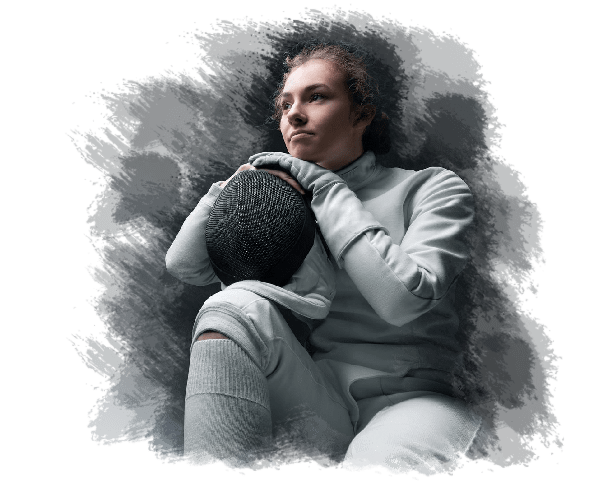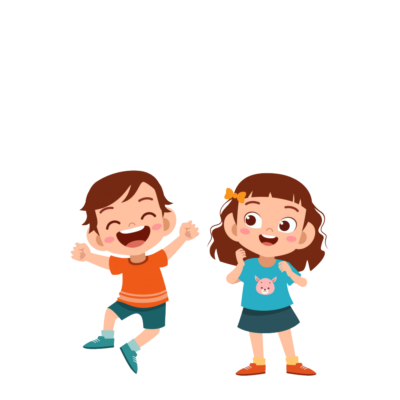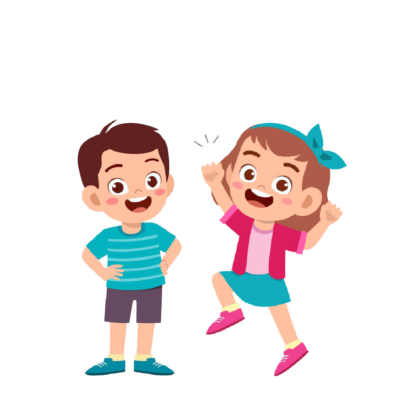The curriculum and targeted output of one-on-one lessons vary with age.
Select the age group to have a closer look at its context.
An introduction
to sports
Age Group: 4-7 Years Old
What are the age-specific needs?
These are the critical ages of early childhood in terms of motor skill development. Children with well-developed motor skills may successfully play and learn any sport with confidence at later ages. Therefore, the primary goal of one-to-one lessons for this age group is to support children’s motor skills development.
How are motor skills developed?
All sport-specific tasks are a combination of the 5 motor skills. These skills are reaction, balance, rhythm, orientation and differentiation. Children develop their motor skills by playing specially designed games. Each game focuses on one of the skills, and also supports physical activity and coordination. Games are chosen according to the needs of the child from the curriculum of more than 1000 games.
How much fencing is taught?
Since it’s not appropriate to teach sport-specific skills to 4-6 years old children, fencing is included in one-on-one lessons such as swordplay. Some basics of footwork and thrusting/cutting actions are shown as the rules of the game, but the correct technique is not insisted upon. The main target of swordplay is to develop coordination and a sense of distance and timing.
What is the structure of the lessons?
The duration of a one-on-one lesson is 60 minutes. Each lesson consists of 3-4 different games that last approximately 40 minutes. The remaining time of the lesson is filled with fencing-specific games.
What is the suggested frequency of the lessons?
Having 1-2 lessons per week is strongly suggested. Please keep in mind that it’s also important to have lessons every week on a regular basis in order to get the most benefit and build the habit of exercising.
Do I need to buy any equipment?
No. All the teaching aids for the games and fencing equipment are provided. Fencing is performed with plastic swords and masks, which are lighter than regular fencing equipment. All you need for the lessons is to wear comfortable sports clothes and sneakers. It is also useful to have a spare t-shirt with you to replace your sweaty t-shirt. An essential part of sports activities is to bring your drinking water with you.
What can I expect in the future?
After the age of 7-8, it’s ideal for the child to move towards a sports activity where sports-specific skills are taught. For a happier and more successful sports career, before focusing on a single sport it’s recommended to try various sports until the age of 13-14. Being one of the best competitive sports for personal development, fencing should always be considered at top of the list.
The best time
to start fencing
Age Group: 8-14 Years Old
Why it is the best time to start fencing?
This age span provides the appropriate basis for teaching sport-specific skills. Since fencing is a very technical sport, it is easier to learn the techniques correctly and build a solid foundation at these ages. It should be noted that sooner is better. Therefore children starting fencing between the ages of 8 and 11 are more likely to get the best results from this process.
How long does it take to learn fencing?
Learning in fencing is a lifelong process. However, it takes a short time to learn the fundamental techniques and game rules needed to go on a fencing piste to fence with someone. Although it varies from person to person, an average of 10-15 one-on-one lessons are sufficient to acquire this knowledge.
What is the structure of the lessons?
For beginners, the duration of a one-on-one lesson is 60 minutes. The lesson consists of two 30-minute parts. In the first part, proper warm-up, physical fitness drills and fencing-specific footwork are done under the supervision of the coach. In the second part, the coach gives a fencing lesson where all the fundamentals are taught and repeated. Intermediate or advanced fencers may skip the first part and take only a 30-minute one-on-one lesson. However, it’s advised to do a 60-minute session because warm-up, physical fitness and footwork are crucial parts of fencing that require professional supervision and guidance.
What is the suggested frequency of the lessons?
Having 2-3 lessons per week is strongly suggested. Taking a one-on-one lesson every 3-4 days on a regular basis is ideal to get the most out of this stage. This frequency helps to better remember things learned during the previous lessons and strengthen the fundamentals. For beginners, it’s always preferable to keep this stage as short as possible and move to the next level, which offers a much more enjoyable experience for the participant.
What is the next level after taking 10-15 lessons?
All the knowledge acquired in one-on-one lessons becomes more meaningful and enjoyable when they are used in a real fencing environment. This is why it’s very important for beginners to join group sessions after taking 10-15 one-on-one lessons. The coach lets the participant know when it’s time to move to the next level and start a club membership to join the group sessions.
Should I become a competitive fencer or keep it as a hobby?
Becoming a competitive fencer or being interested in fencing as a hobby is entirely up to the participant’s decision. Both competitive and hobby fencers are welcome to the group sessions. On the other hand, it should be known that the best way to obtain the most benefits from fencing is to become a competitive fencer. Children from the age of 8 can participate in fencing competitions.
Is it necessary to take one-on-one lessons at later stages?
Although group sessions are an inevitable part of fencing, one-on-one lessons still offer the best technical and tactical practice. They help to sharpen and strengthen the techniques, build a better sense of distance and timing, minimize mistakes and diversify game strategies. As mentioned before, when it comes to fencing, learning is a lifelong process. Therefore for competitive fencers, it is suggested to take one-on-one lessons throughout their carrier.
Do I need to buy any equipment?
No. All the teaching aids and required fencing equipment for one-on-one lessons are provided. All you need for the lessons is to wear comfortable sports clothes and sneakers. It is also useful to have a spare t-shirt with you to replace your sweaty t-shirt. An essential part of sports activities is to bring your drinking water with you. You are going to need to buy your own fencing kit when you join the group sessions.
What should be expected in the future?
Starting fencing at the age of 8-14 is very advantageous for the future. These fencers are more likely to have a better foundation and more experience compared to those who start fencing at an older age. These differences put them a few steps ahead of others when it comes to being good and successful fencers. As a competitive fencer, upon finishing the under cadets (8-14) it’s possible to continue to compete in cadets (14-17), juniors (18-20) and seniors (20+) categories. Whether you choose to become a competitive fencer or not, fencing offers a fun physical activity for a lifetime.
It’s never late
for fencing
Age Group: 15+ Years Old
Is it worth starting fencing as an adult?
When it comes to adults, fencing keeps offering many benefits. It helps people gain the habit of doing sports for a healthy life, as it is a fun sport with many variables that makes you sweat easily and burn calories quickly without counting the minutes. On the other hand, it allows experiencing competitive sports in competitions suitable for any level at age.
How long does it take to learn fencing?
Learning in fencing is a lifelong process. However, it takes a short time to learn the fundamental techniques and game rules needed to go on a fencing piste to fence with someone. Although it varies from person to person, an average of 10-15 one-on-one lessons are sufficient to acquire this knowledge.
What is the structure of the lessons?
For beginners, it is suggested to do a 60-minute session in order to be considered a beneficial sporting activity. This session consists of two 30-minute parts. In the first part, proper warm-up, physical fitness drills and fencing-specific footwork are done under the supervision of the coach. In the second part, the coach gives a one-on-one lesson where all the fundamentals are taught and repeated. Intermediate or advanced fencers may skip the first part and take only a 30-minute one-on-one lesson. However, it’s advised to do a 60-minute session because warm-up, physical fitness and footwork are crucial parts of fencing that require professional supervision and guidance.
What is the suggested frequency of the lessons?
Having 2-3 lessons per week is strongly suggested. Taking a one-on-one lesson every 3-4 days on a regular basis is ideal to get the most out of this stage. This frequency helps to better remember things learned during the previous lessons and strengthen the fundamentals. For beginners, it’s always preferable to keep this stage as short as possible and move to the next level, which offers a much more enjoyable experience for the participant.
What is the next level after taking 10-15 lessons?
Although it is the individual’s choice to continue fencing with one-to-one lessons or to enrich it with group sessions, it is highly recommended to join group sessions after taking 10-15 one-on-one lessons. In fact, all the knowledge acquired in one-on-one lessons becomes more meaningful and enjoyable when they are used in a real fencing environment. Group sessions are also important to keep fencing as a long-lasting sporting activity. The coach lets the participant know when it’s time to move to the next level and start a club membership to join the group sessions.
Should I become a competitive fencer or keep it as a hobby?
Becoming a competitive fencer or being interested in fencing as a hobby is entirely up to the participant’s decision. Both competitive and hobby fencers are welcome to the group sessions. On the other hand, it should be known that the best way to obtain the most benefits from fencing is to become a competitive fencer. In Great Britain, there are competitions for any level and age.
Is it necessary to take one-on-one lessons at later stages?
Although group sessions are an inevitable part of fencing, one-on-one lessons still offer the best technical and tactical practice. They help to sharpen and strengthen the techniques, build a better sense of distance and timing, minimize mistakes and diversify game strategies. As mentioned before, when it comes to fencing, learning is a lifelong process. If the individual’s intention is to improve fencing skills, it is suggested to continue taking one-on-one lessons at later stages.
Do I need to buy any equipment?
No. All the teaching aids and required fencing equipment for one-on-one lessons are provided. All you need for the lessons is to wear comfortable sports clothes and sneakers. It is also useful to have a spare t-shirt with you to replace your sweaty t-shirt. An essential part of sports activities is to bring your drinking water with you. You are going to need to buy your own fencing kit when you join the group sessions.
What can I expect in the future?
Starting fencing at the age of 15-20 might still help to have the potential to become a successful competitive fencer. Reaching the elite level seems impossible when starting at a later age. However, this should not stop people from competing. As mentioned before, there are competitions for any level and age including veteran categories such as 40+, 50+, 60+ and 70+. Whether you choose to become a competitive fencer or not, fencing offers a fun physical activity for a lifetime.







